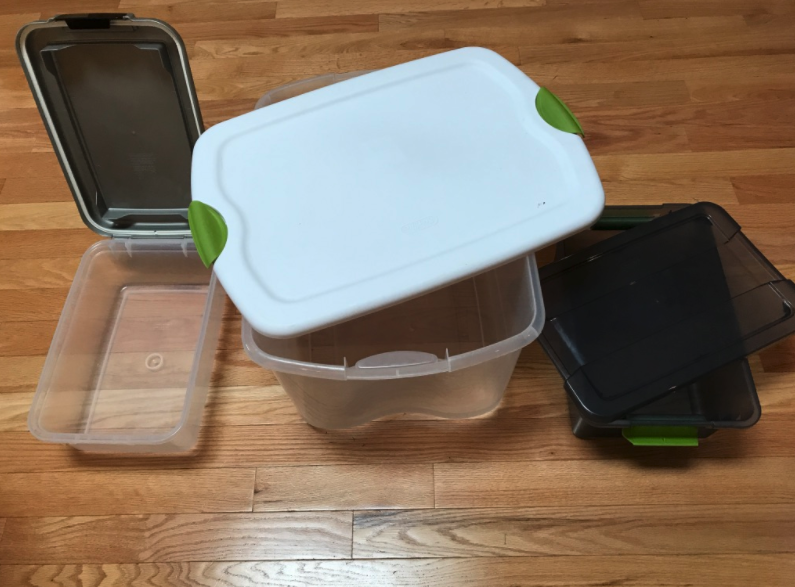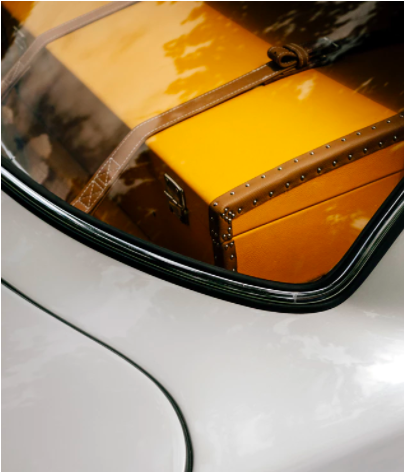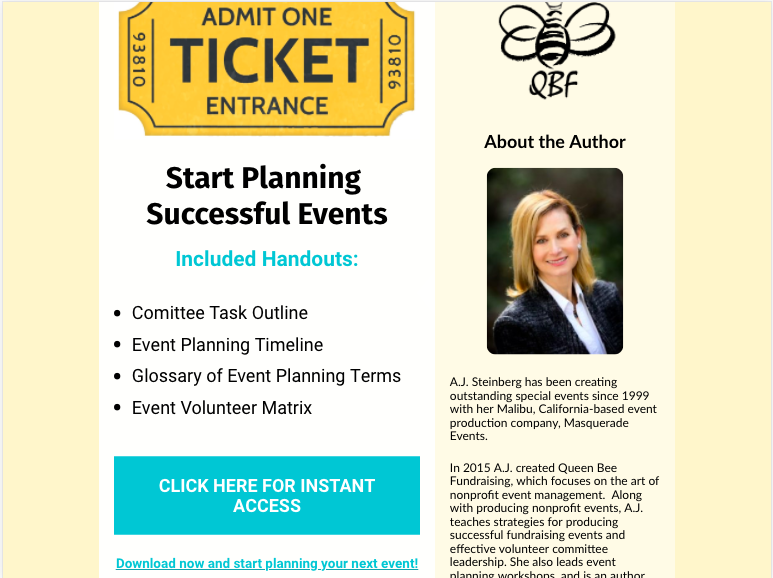“The most common reason events fail is because organizers didn’t do their homework right from day one,” says A.J. Steinberg, founder of Queen Bee Fundraising and principal of Masquerade Events, on a recent episode of podcast Events with Benefits. “That means choosing the right type of event for your audience, creating a specific goal, and marketing successfully.”
With more than 20 years’ experience planning fundraising events, Steinberg knows how to manage events as effectively, and with as little stress, as possible. Today we’ll focus on her tips for hosting charity auctions, including:
- 3 most common auction planning pitfalls – and how to avoid
- Why ticket sales are higher for a first-year event than the third year
- The secret to getting more ‘yeses’ while procuring auction items
- The easiest way to transport and set up auction items
If the content is helpful, be sure to listen to the whole episode and download Steinberg’s free auction planning kit (including resources like the comprehensive Committee Task Outline).
You’ve been planning fundraising events for over 20 years. Tell us about a time an event didn’t go perfectly.
I was working on a nonprofit gala that was held outside on a large ranch in Malibu. I was with the audiovisual team, and we set up right next to the swimming pool. During the audio tech rehearsal, we were testing out the lighting and audio cues for the videos. With 30 minutes before the event began, the lead A/V technician took a step backwards to get a good look at the screen – and he fell into the pool!
Well, you can’t run an A/V board soaking wet, so I ran into the nearest room I could find to get dry clothes. The room turned out to be full of television cameras, filming an episode of none other than The Biggest Loser. I ran around to find a change of clothes, and the only ones I could get were sweats in size XXXXXL. I had to swap alcohol and food to borrow the clothes, but everything worked out.
So that’s just one of my glitch stories.
What are some of the most common pitfalls event planners face?
First, you might have the wrong event for the wrong people. You can either miss the mark with event choice – like a black tie gala for an animal rescue when everybody wants to be outside with their pets.
{{cta(‘c251bc8e-9b36-4c29-a6ed-3beb6b61e263′,’justifycenter’)}}
Next, perhaps you didn’t do the work to think about ticket prices, or how much supporters are willing to spend to attend the event. If you overestimate this amount, ticket sales and attendance will suffer. If you underestimate, you could be losing out on a potential revenue scream.
Finally, a common mistake is unsuccessful marketing. You need to make your event irresistible, which is simple and costs you nothing but creativity. If you don’t do that right, ticket sales will not be successful. If you do, your event is golden.
Suppose you’re planning an inaugural event. Can you expect to make money the first year?
I’m working with an inaugural event right now, and the charity is beginning to realize it’s unrealistic to have modeled their goals after a national charity that pulls in $250,000 per event.
Building a successful event takes time. Be realistic when setting goals every year, especially your first year, and adjust those numbers as you grow. That said, it is realistic to expect to make money the first year. Just know it may not be a lot, nor as much as you’ll make the next year.
One interesting thing to note about ticket sales: They’re easier the first year for an inaugural event than they are for the third year.
Why? The first year, everybody asks all their friends to come. Everyone’s enthused, and it’s the first time they’ve asked people to attend the event. By the third time they ask, their friends are thinking, ‘I’ve been there twice. I just don’t have the time this year.‘ It’s a lot easier to say no. So the third year is a tricky year. You have to work harder to hit your mark.
How can committees improve their success rate while procuring auction items?
I discourage having squads of people descend upon shopping areas in your local town. Lots of times groups of volunteers will be assigned different shopping centers – ‘Okay, you go to this mall, you go to this plaza…’ Going and asking blindly is the least effective way to spend your time and energy.
You procure items when you’re actually purchasing items or participating at a business.
If you’re eating dinner at your favorite restaurant, that is the time to ask. If you’re at the dog groomer picking up your dog, picking up dry cleaning… When you’re handing over your credit card, you ask in return if they would like to participate. That is when you’re most likely to be successful.
Also, the wording is important. People on procurement committees always tell me, ‘I hate asking for stuff.’ Let’s change that mindset.
You’re not asking for stuff.
You’re offering businesses an opportunity to participate in something meaningful in your community.
That is the difference between a yes and a no.
{{cta(‘8ee7d503-c9ba-4b63-83cd-0d389f063597’)}}
Lastly, have enough varied items but not too many. I’d say 3 or 4 guests to 1 item. Get items that are at all different levels of prices – not just expensive and not just bargains. You want enough variation so everyone who is a guest feels they have an opportunity to bid on something. If everything costs too much, some people will feel snubbed; at the same time, you also want exciting items to cater to the high rollers, like a trip to New Orleans.
{{cta(‘f5276871-e571-457e-b33f-509d9ad06987′,’justifycenter’)}}
(By the way, I did a Winspire trip to New Orleans, and it was the best trip ever! In fact, someone bought the trip and handed it over to me.)
Speaking of no-risk travel: What are your thought on consignment auction items?
Consignment is great, especially for live auctions, when there’s holes in the auction catalog, and we need an amazing item to draw people in. Most nonprofits simply don’t have the resources to get a trip to a Super Bowl or Istanbul or Paris. Having a couple big-ticket consignment travel packages gets people to walk away from your event thinking, ‘That was a high-end, amazing event. Look at some of those items they got!’
Working with a consignment travel provider also means your donors will get an experience that’s well put together and well curated – a first rate experience. The person going on the trip will get a professional travel agent, and that’s something you probably can’t and don’t want to pull together.
The issue nonprofits have is cost: that it’s not a 100 percent profit for the cause. You have to weigh the cost with the ‘wow factor’ though. Sometimes you just need something to wow people, and that can increase your success.
{{cta(‘0d771a74-45f8-4fa7-800e-0e6d53ecee96’)}}
A.J., you have a ton of great tips. Got anything juicy for those who may just be starting out or looking to improve their event execution?
This is my favorite A.J. secret. When I started in auction management, I was very young and wish I knew this tip: how to load up auction items and collateral materials to your venue without breaking your back!
It takes a lot of energy to load up collateral materials and auction items. We have to get cars, pick up items, lug them across town. Now most nonprofits use those big rubberized bins or boxes.
However, when you’re working at a hotel or country club, you’re not allowed to lug boxes through the lobbies. No hotel that’s worth their weight in gold will let you waltz through with these boxes, because they don’t like the look of it. They’ll make all the cars go to the back and unload at the loading dock, which causes a big chaotic jam.
What I have figured out is to have a collection of rolling suitcases. I have mine, I get them from my friends, I have some of the huge luggages from years back that you can’t fly with anymore. I pack all my auction items in rolling suitcases. I tag each rolling suitcase with its contents: all the entertainment items in one suitcase, one for sports and memorabilia, one for the nonprofit’s collateral.
Then on event day, you roll those straight through the lobby.
You don’t have to lift or do anything, they just roll elegantly. Once the items are out of the suitcases, you zip them up and slide them under tables with tablecloths. At the end of the night, when it’s time to collect everything, you slide the suitcases back out and they’re ready to go.
This saves so many people’s backs of not having to pick up huge boxes and take them across town!
—
Our big thanks to A.J. Steinberg for sharing her expertise. To find out more about Queen Bee Fundraising and her event planning services, visit http://www.queenbeefundraising.com.
Hear the rest on Events with Benefits
This is just a taste of Steinberg’s invaluable advice. Other notable topics include job descriptions for event committees and volunteers, the average life span of an event, and to increase volunteer retention.
Grab a pen and notebook and listen to the entire session below, or visit the full site here.
Finally, click below to request Steinberg’s free ‘Start Planning Successful Events Kit‘, including an event planning timeline, event volunteer matrix and more.
{{cta(’90f1ff92-f671-470b-9d46-61fb90080879′,’justifycenter’)}}






